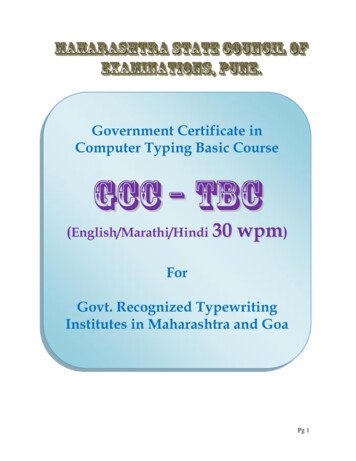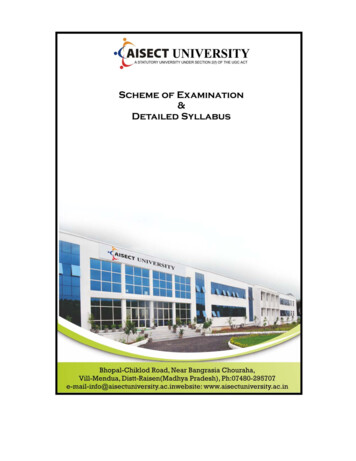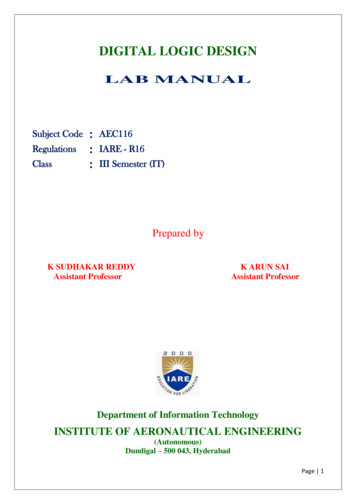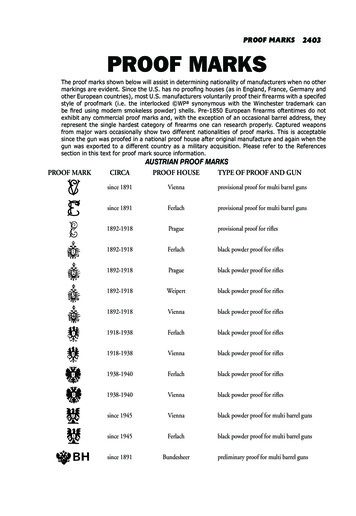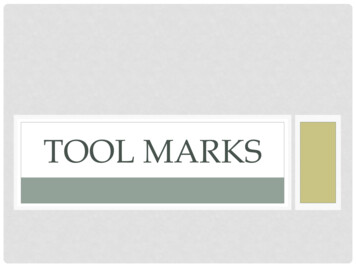
Transcription
TOOL MARKS
WHAT ARE TOOL MARKS? Tool mark—any impression, abrasion, orcut made when contact occursbetween a tool and an object An example of physical evidenceEven mass-produced tools have minordifferencesThe impressions can link the tool to a crimescene and potentially to the ownerForensic Science:Fundamentals &Investigations, Chapter 162
WHAT ARE TOOL MARKS?Types of ImpressionsIndentation Marks Result when a tool is pressed against a softersurface Tools usually leave distinctive marks The hardness of a tool influences theresulting marks left in the softer object May indicate the size of the tool used in acrimeForensic Science:Fundamentals &Investigations, Chapter 163
WHAT ARE TOOL MARKS?Types of ImpressionsAbrasion Marks An object’s surface can be ground orworn away by a tool The harder object causes abrasions onthe softer surface Indentation and abrasion markssometimes occur at the same timeForensic Science:Fundamentals &Investigations, Chapter 164
WHAT ARE TOOL MARKS?Types of ImpressionsCutting Marks Edged instruments can penetrate asofter object and separate it into parts Cut marks are produced along theedge as a surface is cutForensic Science:Fundamentals &Investigations, Chapter 165
WHAT ARE TOOL MARKS?Examples of Cut Marks on BonesForensic Science:Fundamentals &Investigations, Chapter 166
Q: HOW DO WE DOCUMENTTOOL MARK EVIDENCE? Collect tool mark evidence when possible Photograph the evidence with ameasuring device to show scale Measure the size of the impressionForensic Science:Fundamentals &Investigations, Chapter 167
Q: HOW DO WE DOCUMENTTOOL MARK EVIDENCE? Castings preserve tool mark impressions silicone or rubber-based casting materials Cast impressions retain the uniqueindentation marks made by a specifictoolForensic Science:Fundamentals &Investigations, Chapter 168
Q: HOW DO WE DOCUMENT TOOLMARK EVIDENCE? Take pictures and dust for fingerprintsbefore applying casting material Use magnetic dusting powder and siliconematerial The size of the impression should bemeasured and recorded.Forensic Science:Fundamentals &Investigations, Chapter 169
Q: HOW DO WE COLLECT ANDPRESERVE A SAMPLE? Correctly label evidenceWrap small objects with clean paper and placethem in small containers or plastic bagsPack large objects in cartons or boxesRecord—who, where, when, and whyMaintain the chain of custodyForensic Science:Fundamentals &Investigations, Chapter 1610
Q: HOW DO WE ANALYZE TOOLMARK EVIDENCE? Laboratory tool mark analysis identifies: major characteristics defining the type of tool used in acrimeunique characteristics that might distinguish betweenthe same kinds of toolsForensic comparison microscopes examine toolmark characteristics that match a suspect toolForensic Science:Fundamentals &Investigations, Chapter 1611
TIREIMPRESSIONS
Q: What are Tire Impressions? Tire Impressions are the tread designand dimensions of a tire. Tire Tracks are the related dimensionsof the 4 wheels.
Q: What are Tire Impressions? Different Types of Tires: Original Equipment (OE) Tiressold on new cars thousands of cars have same brand and size Replacement Tires:purchased to replace old, worn tires usually different than OE tires
Q: What are Tire Impressions? Design Elements: Grooves: around a tire Slots: across a tire Sipe: small grooves Tread Wear Indicator:raised bar under design;shows after wear
Q: What are Tire Impressions? Noise Treatment: Tire designs arerepeated around the tireto result in noise Design repeated atdifferent pitch lengths tires produces differentnoises
Q: What Evidence Can We GatherFrom Tire Tracks? Track width: measured from rightcenter to left centerTrack width of front tires and reartires are not alwaysthe same.
Q: What Evidence Can We GatherFrom Tire Tracks?Wheelbase: Measured from front center to back center
Q: What Evidence Can We GatherFrom Tire Tracks?Turning Diameter: Diameter of a circle madewhen the wheels are fully turned.
Q: How Can We Recover TireEvidence? Photos taken along with log of location. Since tire tracks are variable alonglength (pitch), entire track should bephotographed (examination quality)with overlapping photos. Ruler included
Q: How Can We Recover TireEvidence? Casts can be made of 3-D impressions Long sections (3 feet) should be cast. Use dental stone
Q: How Can We Analyze TireEvidence? Class Characteristics can be used toeliminate a suspected tire or suggest a tirecould have made the track.Class Characteristics:Size Tread design Some wear marks
Q: How Can We Analyze TireEvidence? To analyze class characteristics: Known tires collected.Inked or 3D impressions can be made forcomparison.
Q: How Can We Analyze TireEvidence? Similar to shoes, class characteristics can beused to identify tire brands or manufacturers Need individual characteristics to narrow downto the specific tire Wear patterns, cuts, gouges, cracks, temporaryalterations (things stuck in treads)Remember, individual characteristics canchange over time.
Forensic Science: Fundamentals & Investigations, Chapter 16 2 WHAT ARE TOOL MARKS? Tool mark—any impression, abrasion, or cut made when contact occurs between a tool and an object An example of physical evidence Even mass-produced tools have minor differences The impressions can link the tool to a crime


